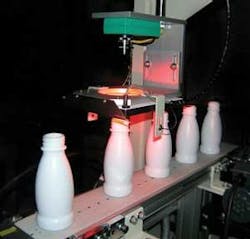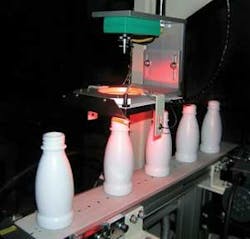Applications keep increasing for smart cameras
A discussion with David Pilliod of Advanced Control Solutions
VSD: How is ACS using machine vision and automated systems?
Pilliod: We have applied machine vision in almost every conceivable industry including automotive, packaging, food and beverage, pharmaceutical, medical devices, consumer products, and general manufacturing. We use machine vision primarily to identify and prevent problems. Smart cameras are applied as error-proofing devices throughout different manufacturing processes. They are a cost-effective solution for the end user, especially as they are being combined with an increasing number of applications that also use 2-D barcodes in the automation process.
VSD: How do you approach a new application? Do you work with OEMs or other system integrators?
Pilliod: Every “new” application starts in the ACS prove-out and automation lab. We have gone to great expense to expand our prove-out capabilities. Our engineering team works closely with our customer to identify all the requirements for an application. Our specifications include identifying the correct camera, lighting, and lens solution, as well as positioning and networking requirements. We also offer technical expertise to program and implement the system on the manufacturing line. Working closely with our automation partners, we have almost every variety of camera, light, and lens on hand to identify these solutions.
Yes, we most definitely work with OEMs and system-integration partners. ACS offers an alliance that assumes a greater level of responsibility for the successful implementation of a machine-vision system. We view ourselves as an extension of an integrator’s engineering department. Our core competence is in applying machine-vision systems in automated solutions to maximize the results and minimize the risk of applying the technology. In many cases, our integrator partners contract our engineers to implement the machine vision portion of the total system.
VSD: What technologies and components do you use in your applications?
Pilliod: In most cases we use smart cameras. We have steered our customers away from custom solutions requiring extensive programming, custom hardware, and difficult-to-maintain systems. Smart cameras are easier for the end user to maintain and support after we leave the job.
We are seeing an increase in applications requiring linescan cameras. And here again the recent release of smart linescan cameras has proven to be a cost effective solution.
Many of our applications are being networked into the end users network. The systems that we have implemented use off-the-shelf network interfacing, again easier to maintain and support for the end user.
VSD: In which areas do you see the most growth? What are users demanding from you in the design of new systems?
Pilliod:There are two areas we see growing-the higher-end smart camera and the “vision sensor.” At the higher end, customers are asking for greater precision in a smart-camera package. This means more pixels and better tools for both gauging and surface flaw detection-a good application for the smart linescan cameras. The smart- camera approach ensures that the system stays in a solution at a minimum cost.
At the lower end, customers are continuously looking for a low-cost solution. Our biggest growth is going to be in an area that replaces a common sensor and our solution in this area is the Cognex (Natick, MA, USA; www.cognex.com) Checker. It is not a repackaged or downsized vision system. From the ground up, it’s an easy to use sensor with easy to use software. In the latest release, the Checker 101E can be integrated into a manufacturing line, tied directly to an encoder and a reject mechanism without a PLC-it’s a totally stand-alone device. The competition for this type of product will be proximity, ultrasonic, and eddy current sensors, not other machine-vision systems. This solution is even easier to install and maintain than the traditional sensor.
VSD:What could vision-equipment manufacturers do to make your implementation jobs easier?
Pilliod: Manufacturers are doing a great job bringing out new hardware and software to meet more demanding applications. Faster processors and new software are making many applications possible, where before a custom solution may have been required. Unfortunately, these new platforms have not been backward-compatible, making older system difficult or impossible to upgrade easily to the newer software. This causes confusion and adds cost when the end user has to maintain multiple software platforms from the same manufacturer.
In a custom vision system designed and installed by ACS, a DVT Legend 500 smart camera inspects plastic injection-molded bottles for dairy products, checking for both the presence of an inner black layer and that the top opening is uniformly oval.
VSD: What kinds of new applications do you expect to emerge, and where do you expect the most growth?
Pilliod: We expect to see an increasing use of machine vision in almost every step of the manufacturing process, with the goal being to prevent any nonconforming component from moving further along in the manufacturing process. We also expect the capability and performance of machine-vision sensors to continually increase. This will open new opportunities where the application of smart cameras will be justified on the basis of cost. These opportunities will be available in almost all areas of manufacturing processes.
Another emerging application and growth area for our type of services is in supply chain management. More and more customers are tracking parts using 2-D barcoding. We see this as a huge growth area for services and engineering.
VSD:How will OEM components targeted toward machine-vision applications have to change to meet future needs?
Pilliod: Until vision sensor technology is accepted as a cost-effective solution over the traditional sensor, OEMs will resist machine vision. OEMs will consider a machine vision solution too expensive to implement into a production machine. To change this mind set, the cost benefit will have to be great enough for the end user to insist that the integrators use a machine-vision solution.
DAVID PILLIOD is president of Advanced Control Solutions (Marietta, GA, USA; www.acs-ga.com), which he founded in 1997. He has a B.S. in mechanical engineering and more than 25 years experience in industrial controls and automation. Editor in chief Conard Holton spoke with him about smart cameras and working with OEMs.


